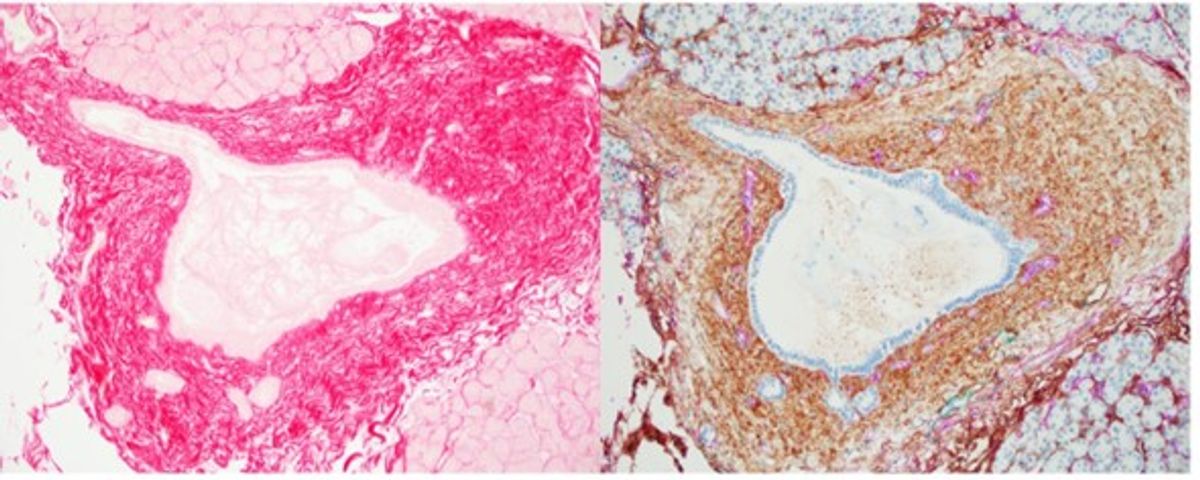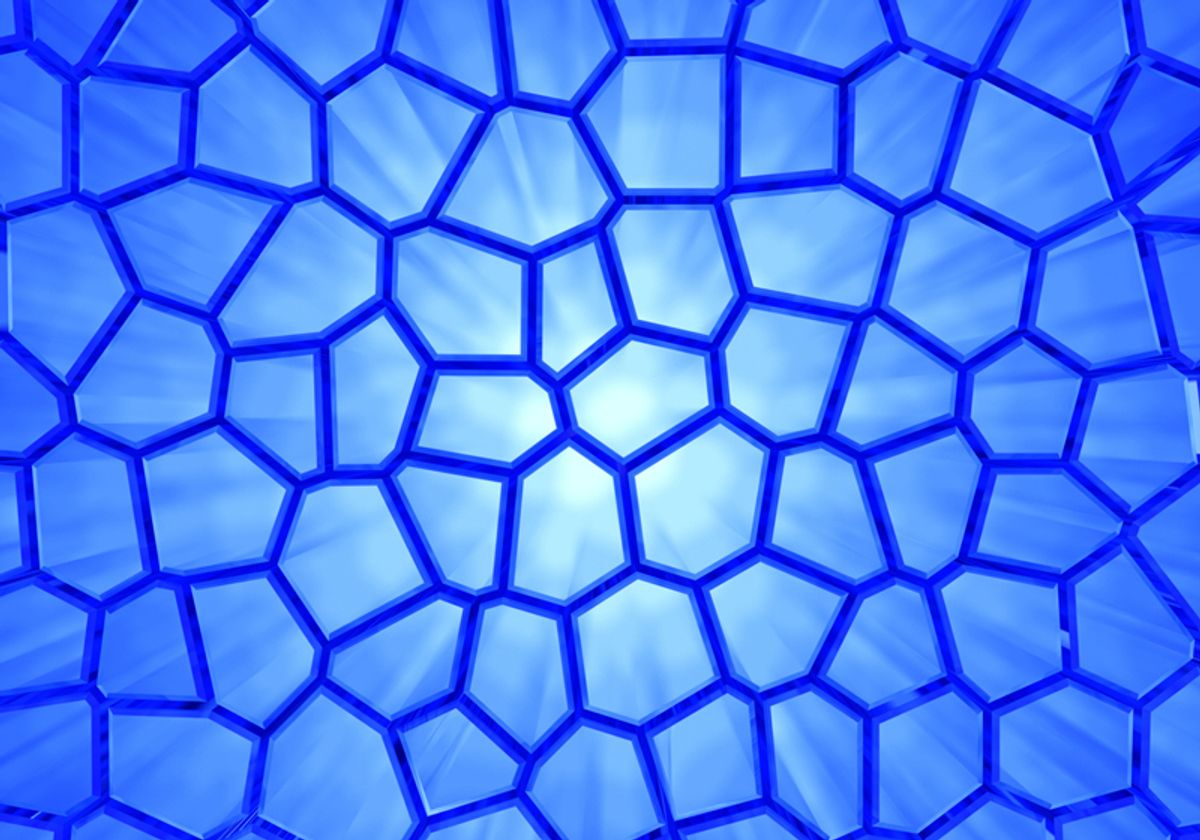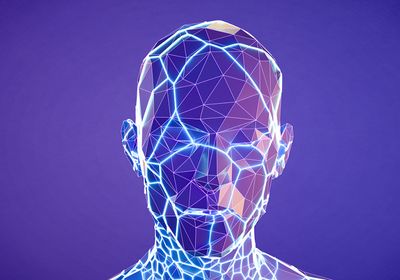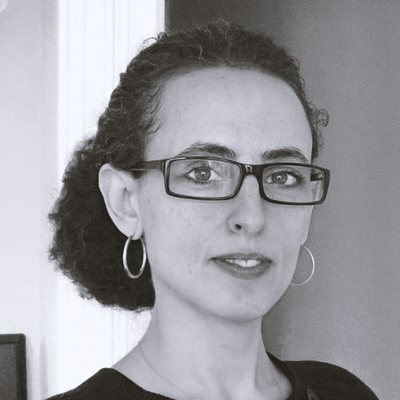ABOVE: The interstitium presents countless opportunities for understanding normal and disease states, with far reaching implications in cell trafficking, molecular signaling, fluid balance, cancer metastasis, and sepsis. © iStock, akinbostanci
The human body is enmeshed in an intricate internal web of living spaces known as the interstitium.1 These fractal-like structures create a vast honeycomb network of fluid-filled openings within and between tissues and organs that spans the body and acts as a thoroughfare. A sophisticated system of connective tissue, including collagen and various other extracellular matrix proteins, supports the continuity of this network. The interstitium is increasingly being recognized as a fundamental anatomical structure and body-wide communication system.
The discovery of the interstitium in 2018 made waves, with many questioning whether scientists had discovered a new organ.1 “It's actually not an organ. It's a system,” said Neil Theise, a medical doctor and professor of pathology at NYU Grossman School of Medicine, whose team made the discovery. “The space itself may be as large as 100 to 200 microns. It's grossly macroscopic, you can see it when you look at any connective tissue in the body, and you can pull it apart with tweezers. That’s not because the collagen easily shreds, but because it's actually a net,” said Theise.
There is a Crack in Everything; That’s How the Light Gets in

Remarkably, doctors and scientists routinely encountered the interstitium but were taught to ignore it. Surgeons regularly removed and discarded portions of this body-wide net and pathologists wrote it off as an artifact of tissue processing. In the latter case, preparing tissue samples for microscope viewing involves a series of steps that include fixation and dehydration. The fluid is removed from the spaces of the interstitium, and the structures collapse down on themselves. “You see these cracks, these little openings in the collagen,” Theise said. “For decades, what I’ve been taught and what I’ve taught people is just ignore that because collagen is so stiff that when you try to section [the tissue] it cracks.” When Theise and his colleagues made their ground-breaking discovery in 2018, they realized that the spaces in living tissue corresponded with the cracks routinely seen in fixed tissue sections on microscope slides. “It turns out those are the remnants of the living spaces,” Theise said.
With this realization, the cracks in contemporary science and medicine were exposed. Despite the vast scientific knowledge that exists about the human body, the picture remains profoundly incomplete. But as poet, singer, and Zen Buddhist Leonard Cohen famously sang, “There is a crack in everything, that’s how the light gets in.” The interstitium may be the missing piece of the puzzle that helps explain the interconnectivity between every cell, tissue, organ, and hidden crevice in the body. “There isn’t a tissue that isn’t riddled with the spaces. The interstitium has the ability to communicate through the body across every scale, from the quantum electromagnetic level, all the way up to the cellular level,” Theise said.
Because the interstitium is a fibrous network, mechanical stimuli that affect a fiber in one area also affect other regions of the body, creating a network of mechanical connectivity. "If you want to communicate a signal, mechanics are so efficient,” said Andrew Pelling, a professor of physics and biology at the University of Ottawa. “It's no surprise that there are all these highly evolved systems to sense and transmit mechanical information."
Theise explained further that the collagen that makes up the interstitium is piezoelectric.2,3 It can convert mechanical force into electrical currents that may carry charged molecules through the interstitium. “Collagen, when you stack it up high enough, becomes a piezo crystal. Any movement of the collagen will generate electrical energy,” Theise said. This may have far-reaching implications from tissue and organ regeneration to gastrointestinal function. 4-6

The interstitium also acts like a sieve in other ways. The spaces of the interstitium are filled with hyaluronic acid, which has a high capacity to hold water, creating a gel. Hyaluronic acid is also highly charged, meaning it can preferentially allow access to certain molecules depending on their charges. In doing so, the interstitium has the potential to modulate the movement of large and small molecules, as well as cells. Although it is not clear how and where they move, the mechanisms may relate to signaling molecules like growth factors, chemokines, and cytokines that create chemical gradients to guide movement. This is particularly relevant for cell migration in the context of cancer cell metastasis through the interstitium.7 “I can show you a tumor marching through these spaces,” Theise said, referring to histopathological tissue slides of cancerous tissue. The interstitium is also believed to be involved in sepsis and fluid balance. 8, 9, 10
You Can Add up the Parts, You Won’t Have the Sum
The Buddhist tenet of interconnectedness plays a strong role in Theise’s life and work. A practicing Zen Buddhist, Theise described the interstitium and his work as a pathologist in almost mystical terms. “My Zen practice is about cultivating beginner's mind, to just be witness to the present moment and not attached to preconceived notions, not anticipating what you think you know will happen. My practice of pathology uses the same method, which is probably not a coincidence.”
Science and spiritual practice came together unexpectedly for Theise one day during a particularly distracted meditative practice. He was ruminating on whether the body is a unique entity or a conglomeration of cells, when he noticed an incense stick turn to smoke on the altar. “Suddenly, there was an instant bridge between the scientific and spiritual side in a way I was not looking for. But once you see it, you’ve seen it; like once you’ve seen the interstitium, you can’t unsee it,” he said.

Yet the interstitium’s extraordinarily complicated net is far from easy to visualize. Theise and his colleagues have broken down the task, mapping the interstitium organ by organ to reveal the continuity of spaces within and between tissues and organs.7 In doing so, Theise also creates interconnections across scientific and medical subspecialities. "It makes sense to me, at least conceptually, that it is such an important space. It's everywhere, it's the interface between all of these discrete systems,” Pelling said. “Biology doesn't tend to create structures that are not important in some way. It's the same as those older notions about junk DNA that are starting to crumble. Biology is extremely efficient."
Contemporary science is successful because of its reductive approach. The human body is, in many ways, like a finetuned machine. But, as Cohen sang, “you can add up the parts, you won’t have the sum.” Understanding how the interstitium works will define more of the rules about how the trillions of cells in the human body communicate across vast distances to create the exquisitely complex system that is the body. How these things all add up are vast scientific questions that will require a meticulously reductive approach as well as cultivation of a beginner’s mind. “If you do any kind of work with dedicated focus, the secrets of the universe are there in what you're doing,” Theise said.
- Benias PC, et al. Structure and distribution of an unrecognized interstitium in human tissues. Sci Rep. 2018;8(1):4947.
- Fukada E and Yasuda I. Piezoelectric effects in collagen. Jpn J Appl Phys. 1964;3(2):117.
- Fukada E, et al. Piezoelectric and related properties of hydrated collagen. Biophysical Journal. 1976;16(8):911-18.
- Levin M. Bioelectric mechanisms in regeneration: Unique aspects and future perspectives. Semin Cell Dev Biol. 2009;20(5):543-556.
- Kamel NA. Bio-piezoelectricity: fundamentals and applications in tissue engineering and regenerative medicine. Biophys Rev. 2022;14(3):717-33.
- Theise ND, et al. The interstitium of the mesentery: contents and inter-organ connections. In The Mesentery and Inflammation. Cham: Springer International Publishing. 2023. 37-55.
- Cenaj O, et al. Evidence for continuity of interstitial spaces across tissue and organ boundaries in humans. Commun Biol. 2021;4(1):436.
- Dargent A, et al. Role of the interstitium during septic shock: a key to the understanding of fluid dynamics? J Intensive Care. 2023;11(1):44.
- Dull RO and Hahn RG. Hypovolemia with peripheral edema: What is wrong?Crit Care. 2023;27(1):206.
- Stewart RH. A modern view of the interstitial space in health and disease. Front Vet Sci. 2020;7:609583.




